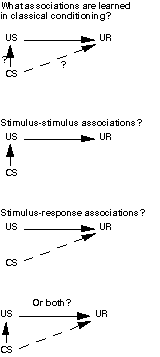| In the basic classical conditioning paradigm there are four components,
US, CS, UR and CR. Although the CR and UR may come to differ markedly,
the initial learned response to the CS is the UR. Through what association
does the CS come to elicit the UR? The figure below shows: initially there
is a link between the US and the UR but none from the CS to the US or UR.
It is quite plausible that making either association would cause the CS
to elicit the UR - during training the CS is a predictor of both the US
and UR (since the UR inevitably follows the US).
After conditioning the CS could evoke the CR through a direct stimulus response association or it could evoke the CR indirectly through an stimulus-stimulus association with the US. In the latter case, when the CS's association with the US evokes some trace of the US in the memory of an animal, this trace, in turn evokes the UR reflexively. In the former case the CS can effectively replace the US, this hypothesis is therefore sometimes known as stimulus-substitution - Pavlov believed this was the underlying mechanism of classical conditioning. Evidence exists to support the involvement of both types of association in classical conditioning. Sensory-preconditioning:
The phenomenon of sensory-preconditioning supports the existence of stimulus-stimulus associations. In sensory pre-conditioning two neutral stimuli which one might use as CSs are repeatedly presented together without any US. One of the stimuli, CS1, is now conditioned to a US so that it elicits a CR. If the other stimulus, CS2, is now presented to the animal in the absence of the US it too elicits a CR. The only explanation can be that the animal learned an association between CS1 and CS2 during the sensory preconditioning phase of the experiment, so clearly these stimulus-stimulus associations are learnable. One cannot, however, clearly infer from this result is that the animal must have learned a stimulus-stimulus association between CS1 and the US during the conditioning phase. Both CS2-CS1-CR and CS2-CS1-US-UR associations could explain the behavior observed. The process of second-order conditioning is, in some ways, a reversal of the sensory-preconditioning procedure. Here CS1 is paired with the US. Thereafter CS2 and CS1 are paired and once again test the subject's response to CS2 alone. CS2 elicits a CR and again it is unclear whether this can be attributed to stimulus-stimulus or stimulus-response associations. Adding a final twist to the experiment, however, provides more conclusive evidence for stimulus-response associations. Switching second-order conditioning USs:
Having established the association between CS2 and CS1, now CS1 is paired with a different US we now finally test the response that CS2 elicits. If conditioning is primarily a matter of learning stimulus-response associations then CS1 will become associated with the response UR1 during the first phase of the experiment and a similar CS2-UR1 association will be produced in the next phase. When CS1 is paired with the new US2 this should not effect the response produced to CS2. If, on the other hand, associations are primarily made between stimuli then the response to CS2 should change when CS1 is paired with US2 through the chain of associations CS1-CS2-UR2. In fact UR1 is produced in the final test phase of the experiment, supporting a stimulus-response model of conditioning. Notwithstanding the evidence above, there is also some evidence that classical-conditioning cannot be based solely on stimulus- response associations. It has been found that interfering with an animal's ability to make a UR during conditioning (for example by temporarily paralysing the animal with curare so that muscular URs like leg-flexion could not occur, or temporarily inhibiting salivation with atropine and so blocking part of the typical appetitive US) does not eliminate its subsequent production of a CR in response to the CS. This is quite incompatible with a simple model of CS-UR association because there is no UR to associate the CS with during conditioning. One attempt to reconcile this result with the second-order conditioning results is to suggest that it is not the UR which becomes associated with the CS, but rather, the motivational state which to which the UR is directed. This explanation would hold that a CS becomes associated with hunger, not salivation, in an appetitive conditioning experiment and fear rather than cowering in conditioned emotional responses. |
